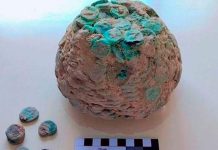The Horster Sonnenstein is a reddish-gray granite porphyry plate with an uneven edge that is about 1.1 meters high and slightly wider. The original sunstone can be found in the Horsten school in the Friedeburger area of Lower Saxony, some 18 kilometers southwest of Wilhelmshaven. A clone is located on “Am Warfacker” street in Horsten.
There are 17 concentric circles (outer diameter 77 cm) put on the flat front surface. A 3.4-cm-diameter hole sits in the middle. The stone was discovered in the early 1900s west of Horsten, and until 1963, it served as the foundation for a garden gate there. The scholar Karl-Heinrich Marschalleck identified it and was able to retrieve it.
The unique stone was restored in 1981, but no finds allow it to be classified. Similar images can be seen on artifacts from the Bronze Age and rock carvings in southern Scandinavia. This motif can be found in megalithic constructions and rock engravings on the British Isles, such as Cup-and-Ring marks. It is possible that the depictions held significance within the context of a Bronze Age religion.
Read More: The Largest Ancient Water Storage Tank in the Balkans








